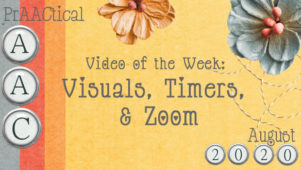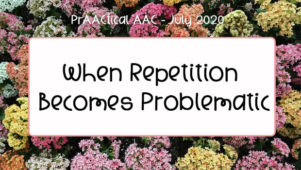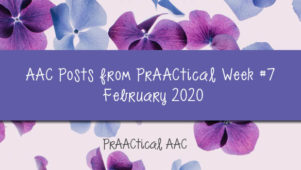Beyond Behavior Problems: How Visual Supports Can Help Our AAC Teaching
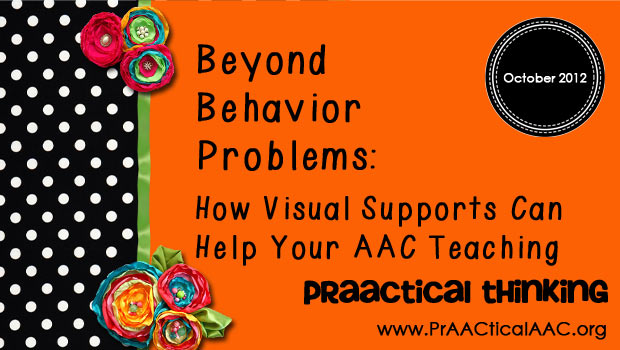
Visual supports are not just for people with behavioral challenges. In this post, we share some ideas of using visual schedules and other supports to enhance comprehension and language learning.
Let’s look put this into a clinical context. Marvin is a high school student with intellectual disabilities and cerebral palsy who is learning to use a high tech SGD. He is a personable young man who engages easily and comes to each session with a ‘ready to learn’ mindset. Most of Marvin’s goals revolve on learning to build sentences using core words. Although he has very limited literacy skills, he really, really wants to learn word prediction. This presented a bit of a dilemma, as I typically don’t begin to teach word prediction until spelling skills are approaching the third grade level. Marvin has some terrific splinter skills but his overall spelling skills are probably around the mid-first grade level.
What to do? In this situation, motivation trumps reason. Marvin is clearly motivated to learn a specific strategy, and it would be counterproductive not to prioritize what he values. So, along with everything else, we are teaching word prediction. Of course, it is his favorite part of each session.
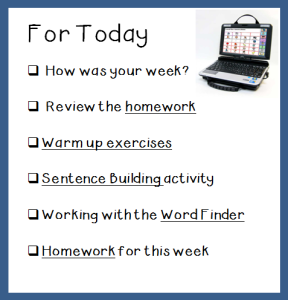 While Marvin doesn’t fit the profile of the kind of learner for whom visual supports are typically used, our teaching wouldn’t be nearly as effective without them. Here are four ways we use visual supports in his therapy.
While Marvin doesn’t fit the profile of the kind of learner for whom visual supports are typically used, our teaching wouldn’t be nearly as effective without them. Here are four ways we use visual supports in his therapy.
1. Visual Schedule # 1: Each session has a written agenda with some picture symbol support (a variation of the kind shown here). The written agenda is large, written in student-friendly language, and sits on a tabletop easel (cookbook holder) throughout the session.
- How We Use It: We go over the visual schedule (“agenda”) at the start of the session (speaking and pointing to the words/symbols as we go), refer to it as we transition from one activity to another, and use it to tell his mom what we did that day. One visual support for three different purposes? Yes, please.
2. Visual Schedule # 2: Marvin is learning some things that have multiple steps. We supplement our oral explanation with a visual support that is essentially a mini-schedule. The mini-schedule appears when we are ready to begin that activity. It is fairly large, easy to read, and remains visible throughout the activity. Having a visual explanation of what to do allows Marvin to be more independent in the current task and beyond. If we can teach the strategy of following a set of written, symbol-enhanced instructions to complete a task/activity, the possibilities are endless. (What employer wouldn’t want a kid who can follow directions?!)
- How We Use It: We go over it at the start of the activity so that a) the expectations are clear, and b) so that the steps are fresh in our minds. We refer back to it as we implement the different steps to solidify his understanding of the steps as a process. When attention wanders or if we get off track (Marvin is a real social butterfly), a quick tap on the visual support snaps us back in focus. Works every time.
3. Rules: Complex processes can be made simpler by boiling things down to their essential components. In Marvin’s case, we simplified the process of using word prediction to a couple of basic rules. Having those rules written out (with some symbol support), reminds us all what we need to consider as we move through the activity. We pull out the rules whenever we are doing something that involves word prediction, and keep them handy (on a typing stand) so that we can glance at them as needed.
- How We Use It: First we go over the rules orally and highlight the print/symbols to remind us of what to be thinking about. Then we use them systematically with each new word we type. We consider each new word in light of the rules, asking ourselves if the word fits each rule (one by one). Thirdly, we use it for error management. Unless we are collecting probe data, we try to prevent errors (not correct them). When we see Marvin about to make a mistake, we ge
 ntly interrupt him and redirect to the rule violation that he is making. Finally, we use it for feedback to solidify his understanding. After he responds, we use the rule visual support to tell him what we liked or what worked in the response he just made. “Terrific! You really thought about that last sound and what letter makes that sound. I saw you check all the word choices for one that ended with that letter. Way to go!”
ntly interrupt him and redirect to the rule violation that he is making. Finally, we use it for feedback to solidify his understanding. After he responds, we use the rule visual support to tell him what we liked or what worked in the response he just made. “Terrific! You really thought about that last sound and what letter makes that sound. I saw you check all the word choices for one that ended with that letter. Way to go!”
4. Demonstrating a Pattern: Our brains are pattern seekers. Patterns allow us to learn more quickly so we try to exploit that in our AAC teaching. Marvin is learning to Subject-Verb-Object (SVO) sentences using pronouns and core verbs (e.g., I like it; You see it; She wants it). Because we are already using the modified Fitzgerald Key, Marvin knows that colors have meaning. In this case, pronouns have yellow borders and verbs have green ones. We can use this to give him direction in the sentences he is building: the visual support makes it evident that he is building a Yellow-Green-Yellow sentence.
- How We Use It: Initially, we explain what the visual support means, pointing out the similarity between the colors in the visual support and the colors in his SGD core word screens. The visual support is fairly large and sturdy so that we can refe
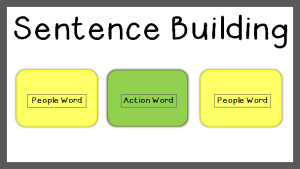 r back to it throughout the sentence-building activity. As we model the SVO sentences, we use the visual support to show how what we just said fits into the pattern that we’re building. We also use it to have Marvin give us advice when we are building our own sentences. For example, if it is my turn to build a sentence, I may start with a pronoun and ask Marvin to help me figure out what color word need to say next. Finally, we review it after each sentence that he built in the activity to solidify the pattern (e.g., “I like that answer. You knew that you had to start with a People Word, which is yellow. Then you went to a green Action Word, and then back to a yellow People Word”).
r back to it throughout the sentence-building activity. As we model the SVO sentences, we use the visual support to show how what we just said fits into the pattern that we’re building. We also use it to have Marvin give us advice when we are building our own sentences. For example, if it is my turn to build a sentence, I may start with a pronoun and ask Marvin to help me figure out what color word need to say next. Finally, we review it after each sentence that he built in the activity to solidify the pattern (e.g., “I like that answer. You knew that you had to start with a People Word, which is yellow. Then you went to a green Action Word, and then back to a yellow People Word”).
Marvin is a sweet, compassionate language learner who may not be the kind of person for whom SLPs would typically use visual supports. We’ve had wonderful experiences in using visual supports with people who don’t have any behavioral problems whatsoever. We’d love to hear how you are using these in your own clinical or educational practice.
Filed under: PrAACtical Thinking
Tagged With: intervention, visual supports
This post was written by Carole Zangari


